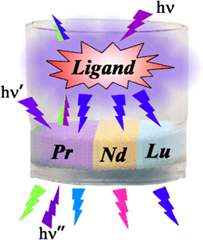ACS Omega 2019, 4 (2), 2669−2675
DOI: 10.1021/acsomega.8b02388
The luminescence of coordination polymers of Pr3+, Nd3+, and Lu3+ with tetrafluoroterephthalate and camphorate, [Ln2(Fbdc)3(DMF)2(H2O)]2 (Ln = Pr, Nd, Lu) and [Ln2(Camph)2(NO3)2(MeOH)]4 (Ln = Pr, Nd, Lu), was studied. Ligand-centered and/or metal-centered emissions appear, which depend on the excitation wavelength, ultimately allowing the emitted light color to be adjusted. Low-efficiency ligand-to-metal energy transfer leads to a difference between the excitation spectra of the tetrafluoroterephthalate- and camphorate-Pr3+ compounds, arising from a primary filtering effect on the ligand-centered excitation, by Pr3+ absorption. A secondary inner filter effect significantly changes the shape of the luminescence band, allowing a wide variation in the emission color, producing, for instance, a purple color, which is not the normal spectral emission. The low-efficiency energy transfer renders tetrafluoroterephthalate and camphorate ineffective as traditional “antenna” ligands for Pr3+ and Nd3+.

